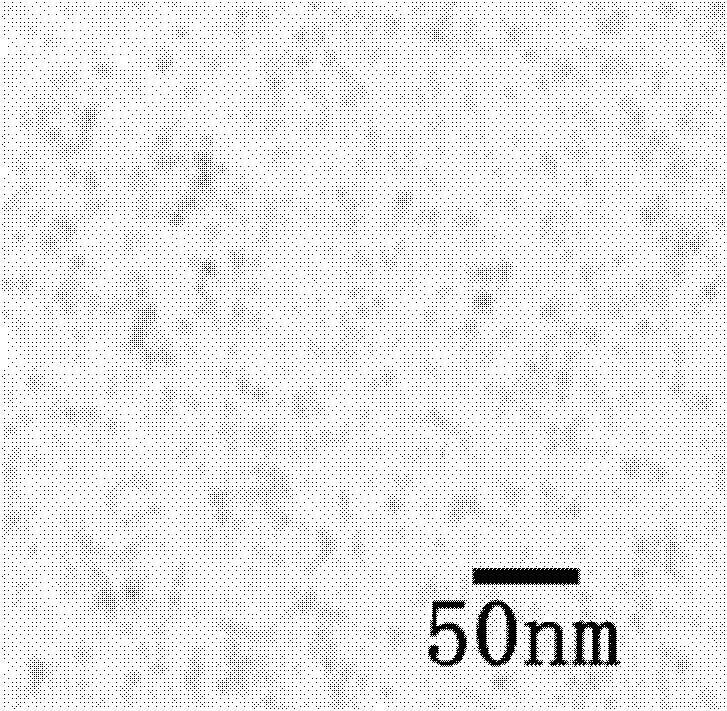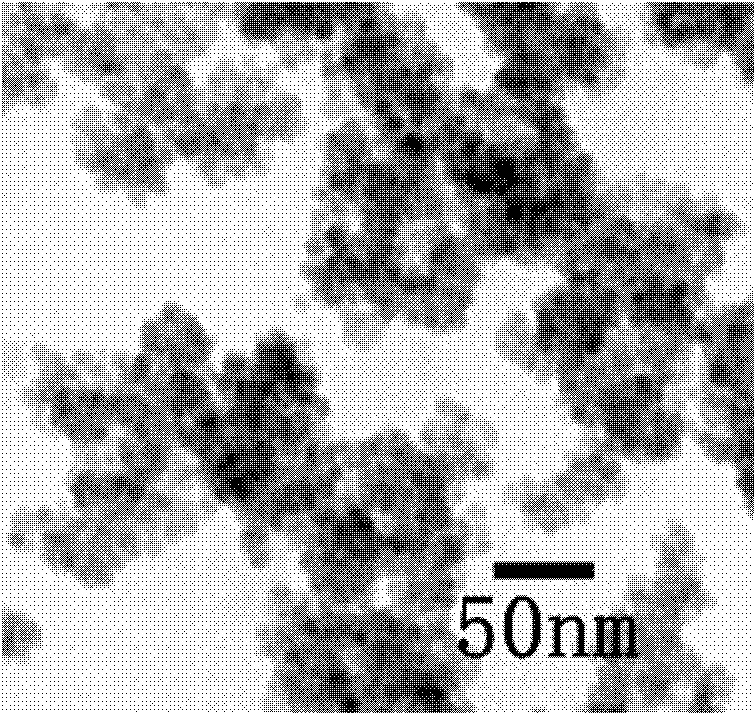Surface modification method of magnetic iron oxide nano-particles
A technology of magnetic iron oxide and nanoparticles, which is applied in the direction of pharmaceutical formulations, preparations for in vivo tests, emulsion delivery, etc., can solve the problems of inability to maintain blood concentration and circulation time, and achieve inhibition of plasma protein adsorption and good stability and biocompatibility, the effect of improving biocompatibility
- Summary
- Abstract
- Description
- Claims
- Application Information
AI Technical Summary
Problems solved by technology
Method used
Image
Examples
Embodiment 1
[0031] (1) Add 2mmol iron acetylacetonate and 25mL triethylene glycol into a three-necked flask and mix thoroughly, heat and stir with nitrogen gas for 2 minutes, raise the temperature to 190°C at a constant speed (0.5°C / min), keep it warm for 10 minutes, and then rapidly increase the temperature (10°C / min) min) to boiling, keep boiling for 30min to stop the reaction, cool, and the resulting reaction solution is flocculated and precipitated with ethyl acetate, separated with a magnet, and then washed 3 times with ethyl acetate to obtain a magnetic Fe 3 o 4 Nanoparticles.
[0032] Magnetic Fe 3 o 4 The morphology of the nanoparticles see figure 1 Transmission electron microscope (TEM) photo. Depend on figure 1 It can be seen that the nanoparticles obtained through the step (1) have a particle size of less than 10 nm, uniform size, and good dispersibility in aqueous solution.
[0033] (2) Take 50mg of the above-mentioned magnetic Fe 3 o 4 After cleaning the nanoparticles...
Embodiment 2
[0038] (1) Add 4mmol iron acetylacetonate and 25mL triethylene glycol into a three-necked flask and mix thoroughly, heat and stir after passing through nitrogen for 4 minutes, raise the temperature to 180°C at a uniform speed (1°C / min), keep it warm for 10 minutes, and then rapidly raise the temperature (8°C / min) min) to boiling, keep boiling for 40min to stop the reaction, cool, and the resulting reaction solution is flocculated and precipitated with ethyl acetate, separated with a magnet, and then washed 3 times with ethyl acetate to obtain a magnetic Fe 3 o 4 Nanoparticles;
[0039] (2) Take 100mg of the above-mentioned magnetic Fe 3 o 4 After cleaning the nanoparticles with dry toluene for 3 times, disperse them in 50ml of dry toluene, ventilate nitrogen, ultrasonically, add 1mlCTCS after 15 minutes, continue the ultrasonic reaction at room temperature for 3 hours, stop the reaction, and use tetrahydrofuran and a mixed solvent (ethanol: water The volume ratio is 1:2) to...
Embodiment 3
[0043] (1) Add 8mmol iron acetylacetonate and 25mL triethylene glycol into a three-necked flask and mix thoroughly, heat and stir after passing nitrogen gas for 2 minutes, raise the temperature to 170°C at a uniform speed (2°C / min), keep it warm for 13min, and then rapidly raise the temperature (6°C / min) min) to boiling, keep boiling for 30min to stop the reaction, cool, and the resulting reaction solution is flocculated and precipitated with acetone, separated with a magnet, and then washed 3 times with ethyl acetate to obtain a magnetic Fe 3 o 4 Nanoparticles;
[0044] (2) Take 100mg of the above-mentioned magnetic Fe 3 o 4 After cleaning the nanoparticles with dry toluene for 3 times, disperse them in 40ml of dry toluene, ventilate nitrogen, ultrasonically, add 0.7mlCTCS after 15 minutes, continue the ultrasonic reaction at room temperature for 3 hours, stop the reaction, use tetrahydrofuran and a mixed solvent (ethanol: The volume ratio of water is 1: 3) to wash the rea...
PUM
 Login to View More
Login to View More Abstract
Description
Claims
Application Information
 Login to View More
Login to View More - R&D
- Intellectual Property
- Life Sciences
- Materials
- Tech Scout
- Unparalleled Data Quality
- Higher Quality Content
- 60% Fewer Hallucinations
Browse by: Latest US Patents, China's latest patents, Technical Efficacy Thesaurus, Application Domain, Technology Topic, Popular Technical Reports.
© 2025 PatSnap. All rights reserved.Legal|Privacy policy|Modern Slavery Act Transparency Statement|Sitemap|About US| Contact US: help@patsnap.com



